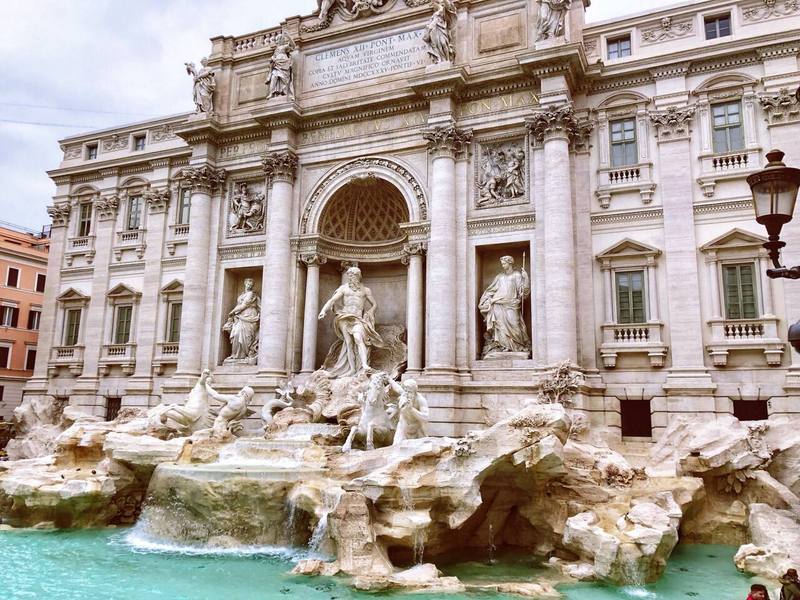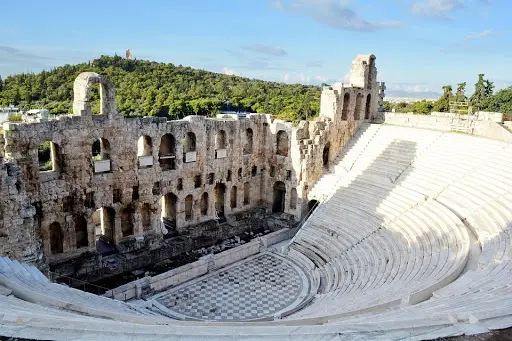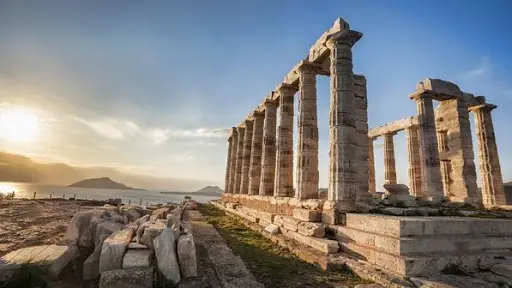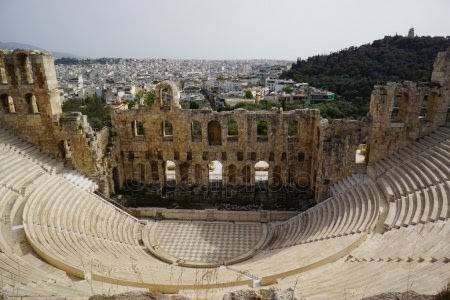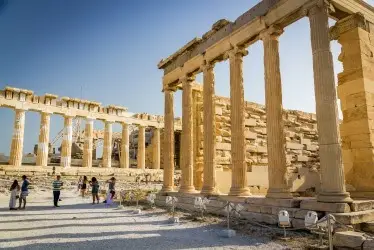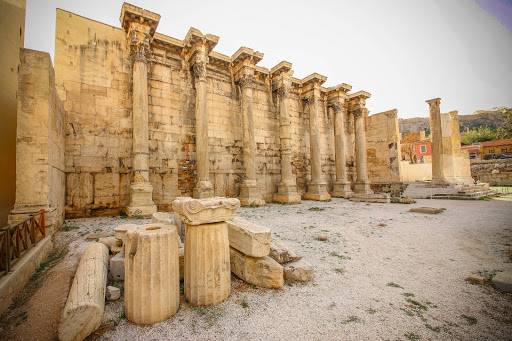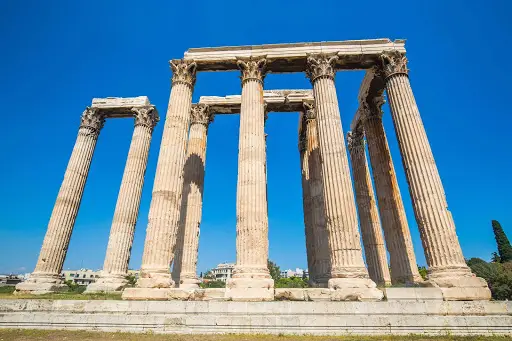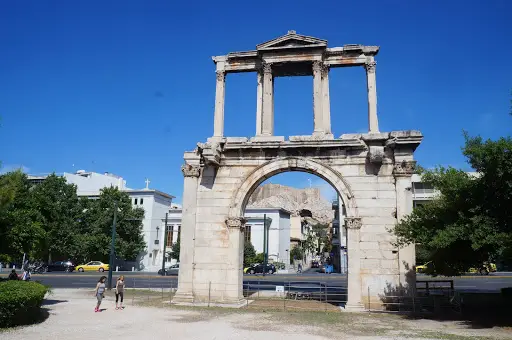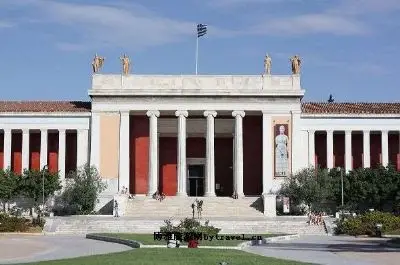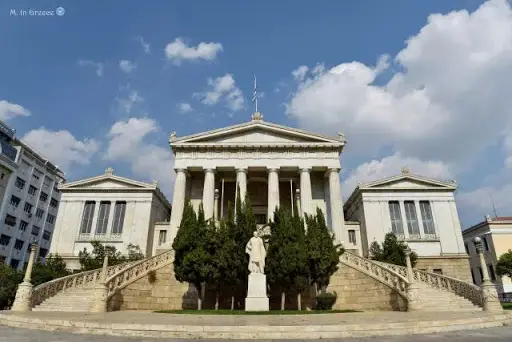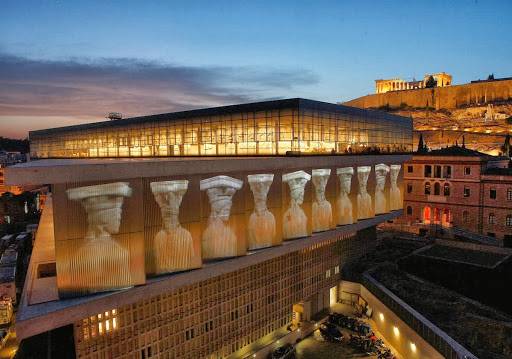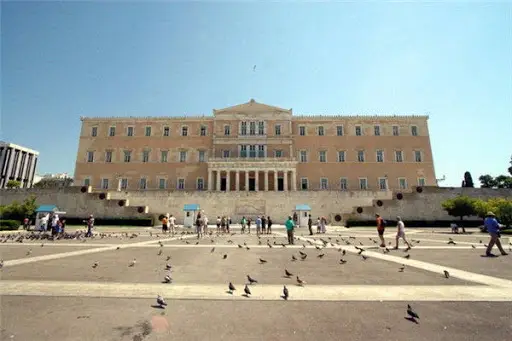Erechtheion
Located north of the Parthenon in the Acropolis of Athens, it is dedicated to many ancient Greek gods. The most notable feature of this temple is the six female statues known as Caryatids standing outside the wall. Each Caryatid has a unique attire, hairstyle, and facial expression, suggesting that they might have existed in ancient times. However, the statues outside the temple now are replicas, with the originals preserved in the Acropolis Museum.
Walking along the streets of Plaka, you enter the Theatre of Dionysus, the place where many great Greek playwrights premiered their works. The Theatre of Dionysus is now in ruins, and the glory of the past is no more. As you ascend the stone steps of the seats, all you hear are the low murmurs of tourists, and you can only faintly imagine the grandeur of the time. In the glow of the setting sun, it seems as if you can hear the wild cheers and unabashed criticisms of ancient Athenians from their seats.
The gathering place of the gods, the place of the gods' revelry. At night, the Parthenon is brightly lit, standing sleeplessly on the high Acropolis hill. On that day, there was a lunar eclipse, and the moon was particularly large and round. Looking through the columns of the Parthenon, it felt as if the enormous moon was so close to us, making us feel so small in this mythical place.
Poseidon, as the uncle of Athena, lost to the goddess of wisdom Athena in the contest for the guardianship of Athens. However, in the hearts of the sea-dependent Greeks, he remains one of the most important main gods, guarding various seas. The remaining dozen or so Doric columns of the temple showcase his unparalleled dignity.
Odeon of Herodes Atticus
The Odeon of Herodes Atticus was built in 161 AD by the philosopher Tiberius Claudius Atticus Herodes during the Roman Empire era to commemorate his wife. It is one of the oldest theaters in the world and one of the most outstanding buildings of its time. The theater is 35 meters wide and has 32 rows of seats, accommodating 5,000 people. In ancient times, concerts and theatrical performances were held here during festivals, and this tradition continues to this day, especially in the summer when there are many concerts. However, it is only open to the public during concert events, and specific times can be checked on the official website.
This is one of the best-preserved ancient buildings in Greece, dedicated to Hephaestus, the god of fire and metalworking. The temple has 34 columns, and around the roof are carvings depicting nine stories from the 'Labors of Heracles'.
The ruins of Hadrian's Library are located north of the Acropolis of Athens, built by Roman Emperor Hadrian in 132 AD. The library building is Roman-style, with interior designs including study rooms, reading rooms, and classrooms. The library was damaged during the Herulian invasion in 267 AD and was restored by Maximus in the fifth century. During the Byzantine Empire, three churches were established inside the library.
The Stoa of Zeus was a building dedicated to Zeus, the god of freedom, and commemorated those who brought freedom to Athens and defended the city. Now, only the foundation remains. It is said that this was the place where the great philosopher Socrates and his friends gathered to discuss philosophy.
The Arch of Hadrian (Πύλη του Αδριανού) is located 325 meters southeast of the Acropolis of Athens. It stands 13.5 meters high and 18 meters wide. Built in 131 AD by Emperor Hadrian, it is a triumphal arch from the Roman era. The structure spans an ancient road in the center of Athens, leading to the eastern side of the city, which includes the Temple of Olympian Zeus. Today, the Arch of Hadrian remains a symbol of the gateway to Athens. Directly behind it are 15 towering columns, which are the ruins of the famous Temple of Zeus. Once adorned with 104 beautiful Corinthian columns, the Temple of Zeus has now become a chaotic, overgrown ruin.
National Archaeological Museum of Athens
This museum, which looks old on the outside and is simply decorated on the inside, can definitely be ranked among the top ten museums in the world for one reason: its heavyweight collections! The National Archaeological Museum is the largest and most richly endowed museum among the more than twenty museums in Athens, and it is also the largest ancient artifact museum in Greece, housing nearly 20,000 highly valuable artifacts, making it a comprehensive collection of ancient Greek artifacts. The museum is divided into two exhibition floors with a total of 50 exhibition rooms. Famous collections include the 'Mask of Agamemnon', the bronze statue of Poseidon, the bronze statue of the boy and horse, the fresco of the boxing boy, and more. The museum is divided into two exhibition floors with a total of fifty exhibition rooms, filled with artifacts from various periods, and it usually takes half a day to see everything. If time is limited, it is recommended to focus on the key artifacts.
The three neoclassical buildings in Athens, collectively known as the 'Neoclassical Trilogy', are the National Library, the University of Athens, and the Academy of Athens. The building in the middle is the University of Athens, whose exterior walls are adorned with images of major Greek deities, making it very beautiful. Flanking the University of Athens are the National Library and the Academy of Athens. The National Library houses a vast collection of ancient Greek books and literary works. The Academy of Athens is modeled after the Acropolis, with two columns outside, each topped with statues of Athena in armor and Apollo holding a musical instrument. At the base of the columns are seated statues of Plato and Socrates.
The new Acropolis Museum opened in 2007 and is an extremely modern building, covering an area ten times that of the old Acropolis Museum. The museum's transparent floor allows a clear view of the ancient city ruins buried underground and reduces energy consumption. The museum houses all the artifacts from the old museum as well as collections from across Greece, including the relief of Athena Nike and the Caryatids of the Erechtheion. Most importantly, the new museum has modern facilities to protect marble sculptures, giving Greece a reason to demand the return of looted artifacts from the British Museum.
This is the square of the Greek Parliament Building and the gathering place for every political demonstration. Below the Parliament Building stand two soldiers dressed in traditional Greek attire guarding the Tomb of the Unknown Soldier. They perform a changing of the guard ceremony every hour, which is also the most popular time for tourists to take photos.
